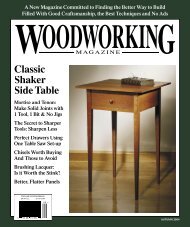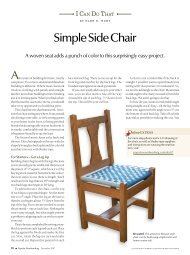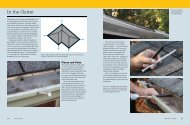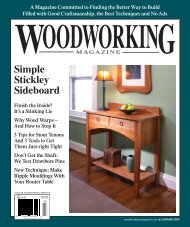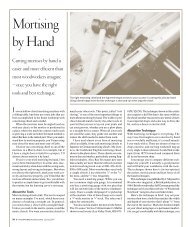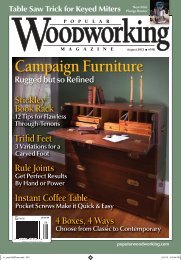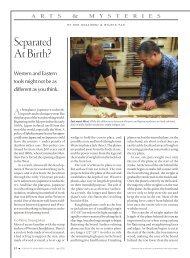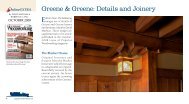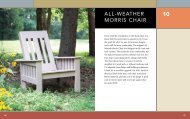Shaker Hanging Cabinet - Popular Woodworking Magazine
Shaker Hanging Cabinet - Popular Woodworking Magazine
Shaker Hanging Cabinet - Popular Woodworking Magazine
You also want an ePaper? Increase the reach of your titles
YUMPU automatically turns print PDFs into web optimized ePapers that Google loves.
Cutting an accurate stopped notch like this isa pain. By ripping the oversized top down andregluing smaller blocks on the ends of the top,you create the perfect notch for the back piece.Centering grooves on your work is child’s play ifyou cut them in two passes. Here you can see thatI milled one half of the groove and have turnedthe piece around to mill the other half.Make the tenons by cutting a rabbet on both sidesof the rails. Use your miter gauge and fence tomake this cut. It’s a safe operation because youcan’t trap your work between the blade and fence.First you’re going to rout the cove detail on threeedges of both the top and bottom.The best way to do this operation is on a routertable that’s set up with a 5 ⁄ 8 " cove bit, though youcan do it hand-held in a pinch. Either way, makesure you rout the detail on the ends first, thencome back and rout the long edge. This will cleanup a good deal of splintering that occurs whenyou exit the cuts on the ends.Next take only the top piece to the table sawand rip the back edge off the board so it’s 7 3 ⁄ 4 "wide. Take the fall-off strip and rip it so it’s 1 ⁄ 2 "wide. Crosscut 1" off each end of that falloff pieceand reglue each end to the back edge of the toppiece, making sure the cove detail matches. Voilà!You have an instant stopped notch in your top.Attaching the top and bottom pieces to thecarcase is easy if your case is square and yourjoints are flush. Before you attach the top andbottom, check their fit against the carcase itself.You want a tight joint at the front and the sides. Ifyou don’t get a seamless fit with only hand pressure,you’ll need to tweak the carcase until youdo. Relying on your clamps to close an imperfectjoint is asking for trouble.Sometimes this process takes a bit of detectivework to figure out what’s wrong. For example,the top of my carcase had an inexplicable“Skill without imagination iscraftsmanship and gives us manyuseful objects such as wicherworkpicnic baskets. Imagination withoutskill gives us modern art.”— Tom Stoppard (1937 – )“Artist Descending a Staircase”but slight bulge in the center, so the top piecewould rock back and forth on it. A sharp blockplane made short work of the problem. As youremove material, try to stay away from the edgesof the carcase. That’s where you can create problemsthat will show in the finished piece.When satisfied with the fit of the top and bottompieces, apply a liberal amount of glue to thecarcase and position the top and bottom in place.When you’ve got them where you want them, nailthem in place through the inside of the cabinet.Use only a couple of nails in each; their job isto hold the top in place as you clamp it. Applyclamps around the cabinet to secure the top andbottom to the carcase and check for gaps.The Stub-tenon DoorBecause this is a light-duty door, we can buildwhat’s called a “stub-tenon” door. Essentially,it’s a traditional mortise-and-tenon door that usesshort (some would say “stubby”) tenons that areonly 1 ⁄ 2 " long. A bigger traditional door would usetenons at least 1" long. We’ve included a tutorialon this style of door starting on page 12.The advantage to these short tenons is theyallow you to build the door without having to cutmortises in the stiles. The 1 ⁄ 4 "-wide x 1 ⁄ 2 "-deepgroove you cut for the door’s panel also servesas the mortise for the tenons on the rails.While stub-tenon doors are a good trick, thereal trick to making perfect doors is to learnabout “horns.” What are horns? Again, take alook at the cutting list and you’ll notice that thestiles are 1” longer than they need to be to fit inthe door’s opening. And both the rails and stilesare 1 ⁄ 8 " wider than called for in the drawing.This extra length and width create what looklike horns on the assembled door. These hornsallow you to make a door that is slightly oversizedwhen compared to the hole in the cabinet.Once the door is assembled, rip and crosscut itsquare to fit perfectly in the door opening. Thereis no easier way to fit a door.So let’s build the door. Cut your stiles, railsand panel to the sizes listed in the cutting list.Now mill the 1 ⁄ 4 "-wide x 1 ⁄ 2 "-deep groove in onelong edge of the rails and stiles. The best way todo this is with a rip blade set to make a 1 ⁄ 2 "-deepcut. A rip blade is best because the top of its teethare flat, so the bottom of your groove also willbe flat. Crosscut teeth will leave “V”-shapedchannels in the bottom of the groove. Positionyour saw’s rip fence so there’s a 1 ⁄ 4 "-wide gapbetween the teeth and the rip fence.Cut the groove first with one face of your workagainst the fence, then turn it around and makethe cut with the other face against the fence. Thismethod ensures that the groove is perfectly centeredon your rails and stiles. If there happens tobe a thin scrap hanging in the middle (as shown inthe photo above center), you can adjust the fenceand make a third pass to eliminate it.Next get your rails and prepare to cut thetenons on the ends. These tenons are made bycutting a rabbet on both faces of the board. Tworabbets make a tenon, as shown in the photoabove right.Set up your dado stack with an accessoryfence just like you did when you cut the rabbetson the side pieces. Bury the dado stack in theaccessory fence so that you’re making a cut thatis exactly 1 ⁄ 2 " wide x 1 ⁄ 4 " deep.Use your miter gauge to guide your railsacross the spinning dado stack. Make a coupleof test cuts on scrap that is the same thickness asyour door stock. Test the fit of your scrap tenonin the grooves you cut in the rails. Fine-tuneyour fence setup and cut the tenons on the endsof both rails.Now fetch your 1 ⁄ 2 "-thick panel. To fit thispanel in the grooves in the rails and stiles youmust first cut a rabbet that is 1 ⁄ 2 " wide x 1 ⁄ 4 " deep20 ■ woodworking magazine Spring 2004



